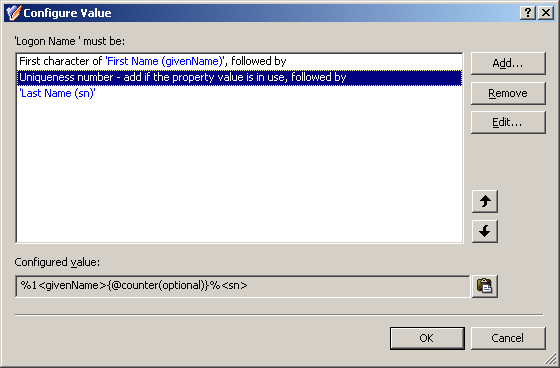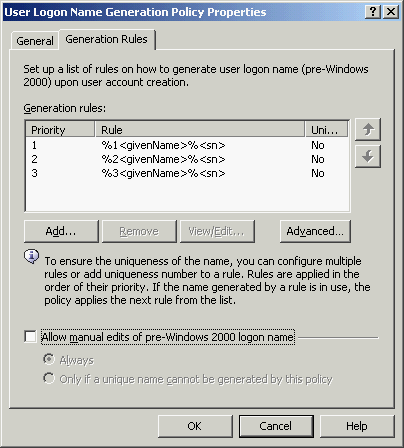Scenario 2: Using multiple rules
The policy described in this scenario uses multiple rules to generate the pre-Windows 2000 user logon name. The rules are as follows:
-
The first character of the user first name, followed by the user last name.
-
The first two characters of the user first name, followed by the user last name.
-
The first three characters of the user first name, followed by the user last name.
The length of the policy-generated name is at most eight characters. If the name is longer, trailing characters are truncated as needed.
Examples of names generated by this policy are as follows:
-
JSmitson
-
JoSmitso
-
JohSmits
The policy generates the name JoSmitso for the user John Smitson if the name JSmitson is in use. If both JSmitson and JoSmitso are in use, the policy generates the name JohSmits.
To implement this scenario, you must perform the following actions:
-
Configure the Policy Object that defines the appropriate policy.
-
Apply the Policy Object to a domain, OU, or Managed Unit.
As a result, when assigning a pre-Windows 2000 user logon name to a user account in the container you selected in Step 2, the Active Roles user interfaces provide a Generate button to create the name in accordance with the policy rules. In the event of a naming conflict, clicking Generate causes the policy to apply a subsequent rule.
The following two sections elaborate on the steps to implement this scenario.
Step 1: Configuring the Policy Object
You can configure the Policy Object you need by modifying the Policy Object that implements the previous scenario; see Scenario 1: Using uniqueness number.
Display the Properties dialog for that Policy Object and go to Policies. Then, select the policy from the list, and click View/Edit to display the User Logon Name Generation Policy Properties dialog.
The Generation Rules tab in the User Logon Name Generation Policy Properties dialog looks similar to the User Logon Name (pre-Windows 2000) Generation Rules page in the wizard you used to configure the policy. You can use that tab to add or modify policy rules.
First, modify the rule to remove the uniqueness number entry. On the Generation Rules tab, select the rule and click View/Edit to display the Configure Value dialog. Then, select the uniqueness number entry as shown in the following figure, and click Remove.
Figure 61: Configure Value

Click OK to close the Configure Value dialog.
Next, configure the additional policy rules as follows.
-
On the Generation Rules tab, click Add to display the Configure Value dialog.
-
In the Configure Value dialog, click Add to display the Add Entry window.
-
Configure the entry to include the first two character of the user first name:
-
Under Entry type, click User Property.
-
Under Entry properties, click Select.
-
In the Select Object Property window, click First Name in the Object property list, and then click OK.
-
Under Entry properties, click The first, and enter 2 in the box next to that option.
-
Click OK to close the Add Entry window.
-
In the Configure Value dialog, click Add to display the Add Entry window.
-
Configure the entry to include the user last name:
-
Under Entry type, click User Property.
-
Under Entry properties, click Select.
-
In the Select Object Property window, click Last Name in the Object property list, and then click OK.
-
Click OK to close the Add Entry window.
-
Click OK to close the Configure Value dialog.
-
Repeat Steps 1 through 6 with the following alteration:
In Step 3, sub-step d), enter 3 in the box next to the The first option.
After you complete these steps, the list of rules on the Generation Rules tab should look as follows:
Figure 62: Generation rules

Click OK to close the User Logon Name Generation Policy Properties dialog.
Step 2: Applying the Policy Object
You can apply the Policy Object without closing its Properties dialog. Go to the Scope tab and do the following:
-
On the Scope tab, click the Scope button to display the Active Roles Policy Scope window for the Policy Object you are managing.
-
Click Add and select the domain, OU, or Managed Unit where you want to apply the policy to.
You can also use the Remove button to remove items where you want the policy to no longer be applied.
-
Click OK to close the Active Roles Policy Scope window.
-
Click OK to close the Properties dialog for the Policy Object.
For more information on how to apply a Policy Object, see Applying Policy Objects and Managing policy scope.
Group Membership AutoProvisioning
Group Membership AutoProvisioning policies help you automate adding or removing the specified objects (such as user objects) to or from the specified groups.
In case of cloud-only Azure objects, you can use the Group Membership Autoprovisioning policy to automatically assign (or unassign) Azure users and Azure guest users to (or from) the specified O365 group(s) in the same Azure tenant.
NOTE: Policy Object settings specific to Azure cloud-only objects (such as cloud-only Azure users, guest users, or contacts) are available only if your Active Roles deployment is licensed for managing cloud-only Azure objects. Contact One Identity support for more information.
Also, Policy Objects specific to Azure cloud-only objects will work correctly only if an Azure tenant is already configured in the AD of the organization, and Active Roles is already set as a consented Azure application for that Azure tenant. For more information on these settings, see Configuring an Azure tenant and Active Roles as an Azure application.
To set up a policy, select the type of objects you want to provision, select the affected group(s), and then configure the policy rules. Once set up, the policy adds (or removes) directory objects to (or from) the selected groups depending on whether the provisioned objects meet the specified rules.
To help you get started with configuring policy-based administration in your organization, Active Roles includes a set of built-in Policy Objects that offer provisioning and deprovisioning rules to the most typical administrative use cases. To find the built-in Policy Objects, navigate to the following node of the Active Roles Console:
Configuration > Policies > Administration > Builtin
NOTE: Active Roles does not automatically check for changes in directory objects, containers or groups specified for provisioning in the configured Policy Objects. This means that if any changes are made in any directory resources in use in a policy, you must update the impacted policies manually. For example, if a directory group used by a Group Membership AutoProvisioning Policy Group is deleted, the Policy Group must be updated manually to reflect the changes.


